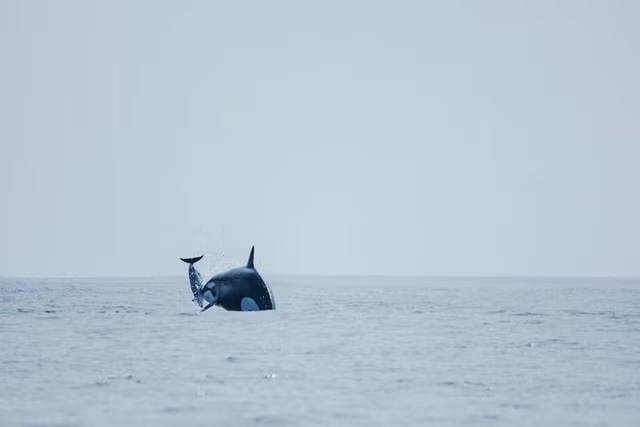Category 4 Hurricane Helene hit Florida's Big Bend late last night, bringing destruction and extremely dangerous storm surges in its wake, with "additional loss of life" feared.
The storm, which had 140 mph winds when it made landfall, has claimed three lives so far, with Florida Governor Ron DeSantis saying that one person died after a road sign fell onto their car as they drove along Interstate 4 in Tampa. Two others are reported to have died in Georgia's Wheeler County after a potential tornado flipped over a mobile home.
"When Floridians wake up tomorrow morning, we're going to be waking up to a state where, very likely, there's been additional loss of life. And certainly, there's going to be loss of property," DeSantis told reporters. "You're going to have people that are going to lose their homes because of this storm. So, please keep those folks in mind; keep them in your prayers."
The storm made landfall just east of the mouth of the Aucilla River at around 11:10 p.m. local time as a Category 4 hurricane, having strengthened rapidly from a Category 1 throughout Thursday. Six states—Florida, Georgia, North Carolina, South Carolina, Alabama, and Virginia—have declared states of emergency due to the storm.
"Tropical storms and hurricanes require several ingredients to get stronger. First, there needs to be warm ocean waters, warmer than about 80 degrees Fahrenheit. The evaporation of this warm water provides the energy a tropical cyclone needs to strengthen," Brian Tang, an associate professor of atmospheric science at the University at Albany, New York, told Newsweek.
"Second, the vertical wind shear cannot be too large, which can otherwise tilt a tropical cyclone. Third, the environment needs to be moist, which helps thunderstorms to grow and be sustained," Tang added.
"Additionally, those thunderstorms need to be close to the center, which, like a figure skater pulling their arms inward, helps to spin up the circulation."
Areas across Florida, North Carolina, and South Carolina have seen over 9 inches of rainfall, and between 6 and 10 feet of storm surge were seen in coastal regions of Florida's Big Bend, where the hurricane made landfall. Catastrophic flooding has been reported across much of Florida, with 65 people needing to be rescued from fast-rising waters in Pasco County. The storm's powerful winds wreaked havoc across Florida and Georgia, sending debris flying through the air and knocking trees and power lines over.
Some 1.2 million people across Florida are without power as of early Friday morning, with 780,000 in Georgia; 380,000 in South Carolina; and 96,000 in North Carolina, according to PowerOutage.us.
"A catastrophic and deadly storm surge is occurring along portions of the Florida Big Bend coast, where inundation could reach as high as 20 feet above ground level, along with destructive waves. There is also a danger of life-threatening storm surge along the remainder of the west coast of the Florida Peninsula," the National Hurricane Center said in a forecast discussion on Thursday night.
"Catastrophic hurricane-force winds are occurring near the coast within the eyewall of Helene and will spread inland over portions of northern Florida and southern Georgia."
The conditions were so hazardous that residents in Florida's rural Taylor County were given a macabre warning by officials.
"Please write your name, birthday, and important information on your arm or leg in a PERMANENT MARKER so that you can be identified and family notified," the Taylor County sheriff's office said in a Facebook post.
"Helene continues to move inland over central Georgia and is producing hurricane-force winds and heavy rainfall. This is a dangerous and life-threatening situation. Persons should not leave their shelters and remain in place, staying away from windows," the National Hurricane Center (NHC) said in an update at 4 a.m. local time.
The storm has weakened back down to a tropical storm after it moved across Florida and into Georgia, and is forecast to weaken further as it travels north through Georgia and into Tennessee and Kentucky.
"Maximum sustained winds have decreased to near 70 mph (110 km/h) with higher gusts. Continued weakening is expected, and Helene is expected to become a post-tropical low this afternoon or tonight. However, the fast forward speed will allow strong, damaging winds, especially in gusts, to penetrate well inland across the southeastern United States, including over the higher terrain of the southern Appalachians," the NHC said in a public advisory.
Rainfall totals of up to 20 inches are forecast across the Southeast and into the Appalachians in the coming hours.
"This rainfall will likely result in catastrophic and potentially life-threatening flash and urban flooding, along with significant river flooding. Numerous significant landslides are expected in steep terrain across the southern Appalachians," the NHC said.
Do you have a tip on a science story that Newsweek should be covering? Do you have a question about hurricanes? Let us know via science@newsweek.com.
Disclaimer: The copyright of this article belongs to the original author. Reposting this article is solely for the purpose of information dissemination and does not constitute any investment advice. If there is any infringement, please contact us immediately. We will make corrections or deletions as necessary. Thank you.



